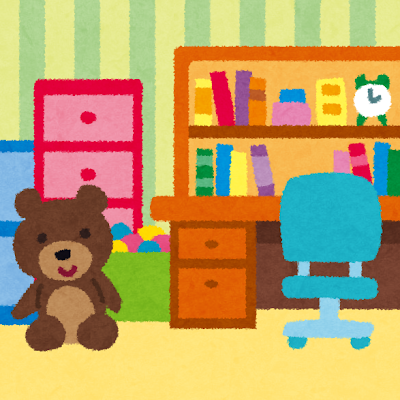Japanese Level 1, Activity #12: “Room and Furniture” / “部屋と家具” (Online)

Image via Irasutoya
Description:
In this activity, students will practice talking about rooms and furniture. They will practice discussing different vocabulary relating to furniture.
Room, Furniture, Location, Conversation, Vocabulary, Japanese, location words, 部屋, 家具, 場所, 会話, 語彙, 日本語、ここ/そこ/あそこ/どこ, Adjectives (Present Tense), 形容詞(現在形), Adjectives (Past Tense), 形容詞(過去形), Adjectives (Noun Modification), 形容詞(名詞修飾), 好き(な)/きらい(な), 〜ましょう/〜ましょうか, Counting, 数
Products: location words, common items
Practices: using common adjectives for common items
Perspectives: What items are commonly found in Japanese homes
NCSSFLT-ACTFL World-Readiness Standards
- Standard 1.1 Students engage in conversations, provide and obtain information, express feelings and emotions, and exchange opinions.
- Standard 1.2 Students understand and interpret spoken and written Japanese on a variety of topics.
- Standard 4.1 Students demonstrate an understanding of the nature of language through comparisons between Japanese and English.
Idaho Content Standards for World Languages:
- COMM 1.1: Interact and negotiate meaning (spoken, signed, written conversation) to share information, reactions, feelings, and opinions
- COMM 2.1: Understand, interpret, and analyze what is heard, read, or viewed on a variety of topics.
- COMP 1.1: Observe formal and informal forms of language.
- COMP 1.2: Identify patterns and explain discrepancies the sounds and the writing system in the target
- language.
NCSSFL-ACTFL Can-Do Statements:
- I can describe the location of familiar items in a room.
- I can ask a peer for the location of familiar items in a room.
- I can use simple descriptive language to distinguish between similar items.
Materials Needed
Warm-Up:
For this activity, students will review location and personal item words to make sure they are prepared for the main activity.
このアクティビティでは、生徒は場所と個人的なアイテムの単語を確認して、メインのアクティビティの準備ができていることを確認します。
Students will take turns asking one another what something is, then answer the question.
生徒は交代でお互いに何かを尋ね、その質問に答えます。
The person who answers the question will then ask someone else in the group. If they don’t know the vocabulary word, the conversation assistant can assist.
質問に答えた人は、グループ内の他の人に質問します。語彙がわからない場合は、会話アシスタントがお手伝いします。
Bedroom
- シャツ shirt
- くつした socks
- しんぶん newspaper
- まくら pillow
- テディベア teddy bear
- テーブル table
- ベッド bed
- まど window
Bathroom
- トイレ toilet
- タオル towel
- シャワー shower
- シンク sink
Office
- いす chair
- つくえ
- ランプ lamp
- シェルフ shelf
- 本 book
- ペン pen
Living Room
- はな Flower
- こども Child
- ねこ Cat
- ソファ Sofa
- テレビ Television
- でんき Electricity
Adjectives
- みどりいろ Green
- あおい Blue
- ちゃいろ Brown
- あかい Red
- きいろい Yellow
- しろい White
- くろい Black
- むらさきいろ Purple
- オレンジいろ Orange
- ピンクいろ Pink
- おおきい Big
- ちいさい Small
Main Activity:
For this activity, we will be using an image that depicts a room with a plethora of objects strewn about.
このアクティビティでは、たくさんのオブジェクトが散らばっている部屋を描いた画像を使用します。
There will be a set of four room slides which will each have their own photo of a room and lists of objects located in the room.
4つの部屋のスライドのセットがあり、それぞれに部屋の写真と部屋にあるオブジェクトのリストがあります。
Ask for the location of the first word on the list with 「犬はどこにいますか?」to a specific student, they should give the answer, and then have that student ask someone else where the next item on the list is located.
リストの最初の単語の場所を「犬はどこにますか?」で特定の生徒に尋ねたら、答えを出してから、その生徒にリストの次の項目がどこにあるかを他の人に尋ねてもらいます。
Continue until the word list has been exhausted and then proceed to the next slide.
単語リストがなくなるまで続けてから、次のスライドに進みます。
Extra Time?
If the students have exhausted the lists within the time limit and have expressed a desire for harder material, ask revisit the same rooms, but this time ask more specific questions.「みどりいろなタオルはどこにありますか」”Where is the green towel?”
生徒が制限時間内にリストを使い果たし、より硬い資料を希望する場合は、同じ部屋に再度アクセスするように依頼しますが、今回はより具体的な質問をします。
An additional bonus activity would be to hide the list of words on one of the rooms (use annotation to draw/scribble out) and then they can ask for locations. (This would be great to promote active recall of vocabulary.)
追加のボーナスアクティビティは、部屋の1つで単語のリストを非表示にし(注釈を使用して描画/落書き)、場所を尋ねることです。 (これは、語彙の積極的な想起を促進するのに最適です。)
Wrap Up
Ask students to point out an object in the room using one adjective.
生徒たちに、部屋にある物体を 1 つの形容詞を使って指摘してもらいます。
End of Activity:
- Read Can-Do statements once more and have students evaluate
their confidence.
(Use thumbs up/thumbs down or download our student cards.) - Encourage students to be honest in their self-evaluation.
- Pay attention, and try to use feedback for future activities!
NCSSFL-ACTFL Can-Do Statements:
- I can describe the location of familiar items in a room.
- I can ask a peer for the location of familiar items in a room.
- I can use simple descriptive language to distinguish between similar items.

